9 Best Post-Running Stretches for Runners to Do After a Run
Add these 9 equipment-free best post-running stretches for runners to your normal post-run routine to give your body the cooldown it deserves.
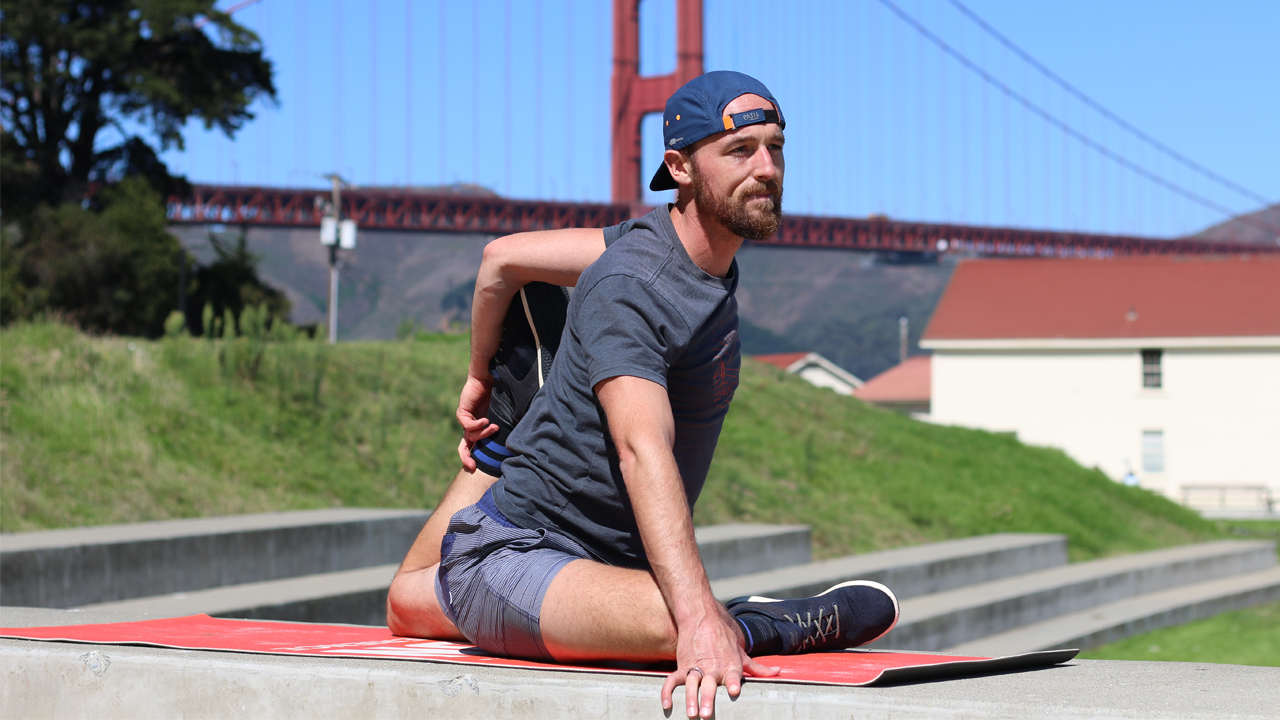
Need a condensed list of the best post-running stretches for runners? You’ve come to the right place. While there are hundreds (maybe thousands?) of post-run stretches you could be doing, we wanted to help you get the most bang for your buck.
Because you’re a runner…and you have other things to do besides stretching for hours a day.
If you’re anything like so many other busy folks, you may not be taking the time to properly cool down with post-run stretches. More likely, as soon as you hit your goal time or mileage, you jump into your car and head home or spend the rest of your day sitting at work.
Resist that temptation. Give your body some TLC at the end of your workout with these post-run stretches for runners. These post-running stretches help:
- Prevent soreness
- Restore range of motion
- Promote blood flow
- Decrease muscle soreness
- Accelerate recovery
Below, we’ll walk you through the 9 best post-run stretches for runners and how to do them.
Stretching After Running: Yes or No?
The debate over whether runners should stretch after running has been a longstanding one, often sparking diverse opinions within the running community. To address this question, it's essential to look at the benefits and potential drawbacks of post-run stretching, and how it can be tailored to individual needs.
Benefits of Post-Run Stretching
- Promotes Flexibility and Range of Motion: Regular stretching after running can help maintain and even improve flexibility and range of motion in your joints. This increased flexibility can enhance your running stride and efficiency.
- Aids in Recovery: Stretching helps in promoting blood flow to the muscles, which can speed up the recovery process by flushing out toxins and reducing lactic acid build-up. This can lead to decreased muscle soreness and quicker recovery times.
- Reduces the Risk of Injuries: Tight muscles are more prone to strains and injuries. Stretching can help alleviate muscle tightness and balance muscle groups, potentially reducing the risk of common running injuries.
- Mental Cool-Down: Stretching serves as a transitional activity that signals to your body that the workout is over. This can be a valuable time for mental relaxation and reflection, an important aspect of any training regimen.
Potential Drawbacks
- Overstretching: There's a risk of overstretching or stretching improperly post-run, which can lead to muscle strains or injury. It's important to stretch gently and not force your body into uncomfortable positions.
- Time and Effort: For some runners, especially those pressed for time, a stretching routine can feel like an extra chore. However, even a short, focused stretching session can be beneficial.
To Stretch or Not to Stretch?
Given the benefits, incorporating post-run stretching into your routine is generally recommended. However, it's crucial to approach stretching with awareness and moderation.
Here are some guidelines:
- Listen to Your Body: If you're experiencing a lot of tightness or soreness after running, your body may benefit more from stretching. On the other hand, if you're not feeling particularly tight, a shorter stretching routine might suffice.
- Quality Over Quantity: Focus on quality stretches that target the major muscle groups used in running - calves, hamstrings, quads, hip flexors, and glutes. You don’t need an extensive or time-consuming routine to reap the benefits.
- Tailor Your Approach: Your stretching routine should align with your running intensity and volume. After a particularly long or hard run, a more thorough stretching session can be more beneficial.
- Incorporate Variety: Mix static stretches with dynamic ones. While static stretches involve holding a position, dynamic stretches include gentle movements that mimic the motion of running, helping to cool down the body gradually.
- Stay Informed: Be aware of the latest research and recommendations regarding stretching, as understanding and approaches can evolve.
How to Stretch After Running
During any run, your body puts out a lot of effort. Your heart rate increases, you sweat and breathe more heavily, and your arms, legs, and feet repeat thousands of repetitions of the same back-and-forth movement.
It’s a lot to ask of your body. Even though it might not seem like a big deal to skip your post-run stretches and mobility, it’s definitely an instance of an ounce of prevention being worth a pound of cure.
The important thing to realize is that leaving your muscles and joints to get stiff and immobile after a run is a sure way to increase your chances of incurring a running injury. After-run stretches might seem like a minor detail, but they can make a big impact.
The stiff soles of your feet after a trail run aren’t just vaguely uncomfortable. They can also prevent your ankle from achieving its full range of motion, which can affect your running form.
Immobile ankles could mean you shift your weight into the front of your foot, putting more strain on your calf muscles, so your calves will probably start to ache during every run. With aching calves, your hamstrings might step up to take more of the load. And so on up the chain, with a domino effect of compensations, cramps, and aches.
Using the following movements, avoid ending up like the Tin Man—creaky, stiff, and uncomfortable—and keep your running game in its prime.
9 Best Post-Running Stretches for Runners
Untie Your Shoes To Start Your Post-Run Stretches
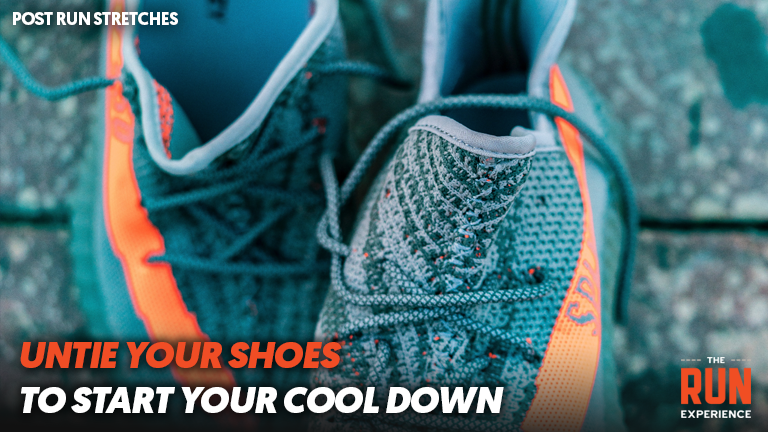
Start your cool down and stretching routine by walking the final 5-10 minutes of your route, whether on the road, trail, or treadmill. Take a second to untie your shoes — it’ll give your feet a chance to breathe, and it will take away the temptation to start running again or skip this part of the cooldown altogether.
Whenever possible, do your after-run stretches with your shoes untied or off.
Plus, it feels good! Your feet tend to swell a bit when running from the impact and increased blood flow, so loosening your shoes to give them more room is a nice relief.
Move On To The Hip Flexors and Hamstrings
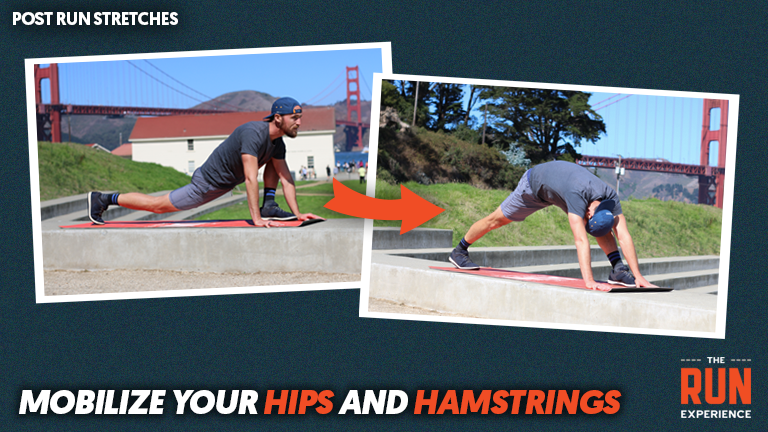
Once your walking cooldown is complete, you’ll bring some of that dynamic movement we mentioned to your hips and hamstrings. If either area gets too tight or stiff, chances are not only will you feel some soreness the next day, but you may also experience lower back pain. Tight hip flexors can put tension on your pelvis, tipping it out of a neutral position. To read about the implications of hip posture on your running form, dive into this article, “Hip Posture: The #1 Way To Achieve Proper Run Form.”
For a hip flexor stretch, our go-to movement is hip circles. With this movement, you’ll get a nice, deep stretch in the front of the hip which may feel tight and stiff from the repetitive movement pattern of running.
- Start in a deep lunge with hands on the ground, left leg forward and right leg extended back.
- Imagine drawing circles on the ground with the front of your right hip and your knee.
- Keep the glutes of your right leg squeezed to help drive the hip forward and prevent hyperextending the lower back.
- Complete 10 circles each clockwise and counterclockwise.
Once you’ve opened up those hips, your hamstrings are primed for their turn.
- With the left leg still bent in front of you, straighten that leg by pushing your hips up and back.
- As your left leg straightens you’ll feel a stretch in the hamstring.
- Drop back down into the lunge for just a moment, then push back again into the hamstring stretch.
- Rock back and forth for a good 10-20 repetitions.
- Don’t forget to breathe as you move!
Switch legs and repeat on the other side.
Shift The Focus To Your Ankles

Use this opportunity to create a deeper range of ankle flexion than you typically get while running. Preserving range of motion and mobility in the ankles and calf muscles can go a long way to avoiding common running injuries such as Achilles heel pain and plantar fasciitis. Both of those injuries can occur when the muscles and ligaments throughout the calf, ankle, and foot become tight and restrict motion. You’ll work on your ankles and calves here, and get to your feet in the next section.
- Find a post, a bench, a wall…something you can lean into.
- Place your right foot 6-12 inches back, and bend the knee to bring it forward, trying to touch the post.
- Keep the forward knee tracking laterally along the outside of the foot, avoiding any inward twisting of the knee.
- If you don’t have anything available, a classic downward dog position is a great substitute. If using this position, pedal the feet to get in that ankle movement and stretching.
- You should also feel a gentle calf stretch in either position.
Repeat this motion for about 20 repetitions, then switch sides.
These are some of our favorite after-running stretches, and you’ll probably be joining the bandwagon after you give them a try.
Finish Your Post-Run Stretches With Your Feet

Don’t forget to add feet work to your post-running stretches.
At the end of the movement chain, your feet do a lot of work. They absorb a ton of impact on each running step, help propel you into your next stride, and keep you balanced across the terrain.
By taking a moment to stretch them at the end of your run, you’ll be able to undo some of that damage and build more flexibility and dexterity in your feet and toes. Plus, as with all these stretches, it just feels good!
- Get down into a squat, with one foot staggered in front of the other.
- Press the toes of the back foot firmly into the ground.
- You can keep your hands on the ground, and lean forward, letting the heel of the back foot come off.
- Be careful not to come so far up you are resting on the ends of your toes. No ballerina moves here!
- You can also do this move while standing in a shallow lunge position. Bonus opportunity here for a little extra stretch for the hip flexors.
- Repeat 20-30 times in a rocking motion on both sides.
With these simple moves, you’ll be so much better prepared to carry on with the rest of your day, your next run, and your injury-free training routine.
If your upper body is feeling like it needs an equal opportunity to cool down and mobilize, follow along with Coach Nate in this upper body stretching and mobility video:
Stretching for Beginner Runners
If you’re brand-new to running, your stretching will look a little different. Stretching for beginner runners takes a gradual investment and slow progression—you don’t want the stretching to be the thing that causes an injury!
In this section, we discuss which are the best stretches for runners and one of the most IMPORTANT beginner running tips on how to stretch after running for building longevity as a healthy runner. Don’t forget to include them in your running program to get the best results from your running workouts.
1. Stretching Is Not An Option
Like any other physical activity, running requires strength. Strength requires muscle. And, muscle requires regular maintenance.
You don’t expect any other machine (your car, refrigerator, blow dryer) to operate day in and day out for you without your taking care of it.
The same goes for your body…and more specifically, your running body. You’ve GOT to be stretching, every SINGLE day. Let me repeat that.
EVERY. SINGLE. DAY.
Lucky for you, the research has already been done. So let’s break “stretching” down for you!
2. How You Stretch Matters
By now, you’ve probably realized how different your body feels before and after you run.
Pre-run: Achy quads, hip flexors, and calf muscles, cold, stiff lower back, your breathing is shallow
Post-run: Warm, sweaty, more mobile, you’re able to take longer, deeper breaths
Knowing this, one of our running tips for beginners is that stretching incorrectly can get you injured, quick! Doing harsh, static (still) stretching exercises before you’re warmed up is like yanking on a rotten rubber band. It’s not going to be pretty.
Stretching before your run:
- It should be dynamic (movement-based).
- Shouldn’t hurt.
- The range of motion will be smaller.
- Should help to increase the heart rate and warm up the body.
Stretching after your run:
- It can be a mix of dynamic stretching and static stretching (holding still in one position).
- This should help slow your heart rate.
- The range of motion will be better.
- It can physically help lengthen the muscles using the heat generated by the run.
- This should increase your overall flexibility, longterm.
Understanding these differences from the get-go will benefit you greatly, and most importantly help you in preventing running injuries!
Bonus After-Running Stretches
Side Bend Stretch
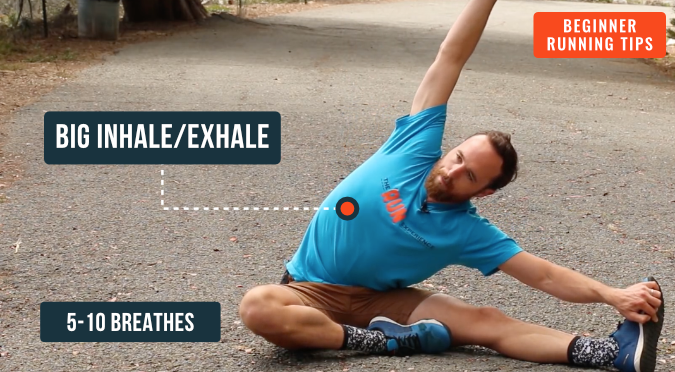
Ok, so you just finished your run. Maybe you walked some, but you definitely ran.
You’re sweaty, out of breath, and probably ready to stop moving. Try this out:
- After your heart rate has calmed down a bit (this part is important!), take a seat.
- Bend your left leg in, “butterfly” style.
- Extend your right leg out to the side.
- Wrap the arm of the extended leg around the front of your waist for support.
- Reach the other arm toward the sky, right next to your ear.
- Take a big inhale.
- Then, take a big exhale and bend towards the extended leg.
- Take a big inhale.
- On the next big exhale, bend even further toward the extended leg.
- Repeat this for 5-10 breaths.
- The exhale is where the magic happens. Your muscles can relax on the exhale, allowing greater length and easier bend.
- This is great for opening up your side body, where a lot of your deep breathing and core engagement occurs.
After that:
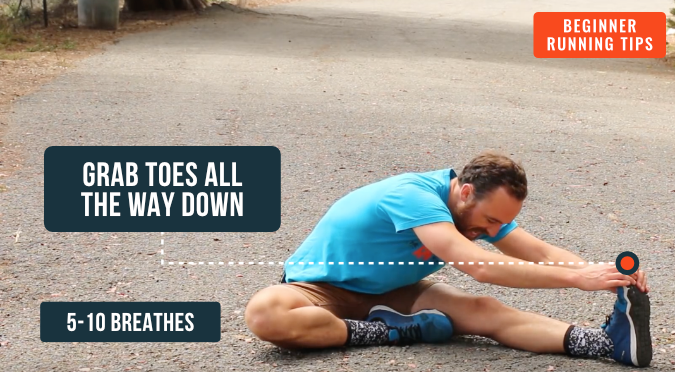
- Keep your legs in the same configuration but return your body to “upright”.
- Now rotate your torso to face the extended leg.
- You can keep both arms on the extended leg, reaching out near the toe.
- Now repeat the 5-10 inhales & exhales.
- Again, use the exhales to find a greater stretch on each repetition.
- This is a GREAT stretch for your hamstring and calf.
- * For increased stretch, flex and hold onto the toe with your hands.
Complete 5-10 breaths of BOTH stretches on EACH leg.
Soccer Stretch: Ultimate Runner’s Stretch
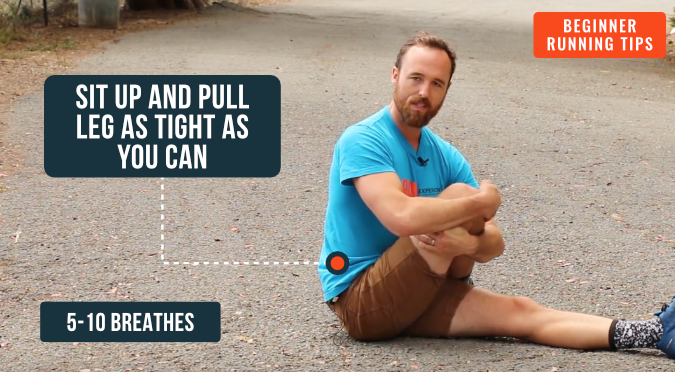
Another post-run favorite. Try this:
- Sit on the ground.
- Extend your right leg out and cross the left leg in a “figure 4” shape.
- Hug the left knee of the crossed leg into your chest.
- Allow your back to round into the position, folding over your bent leg.
- Now take a big inhale.
- On your exhale, try and straighten the back into an upright position, while squeezing the knee tighter to the chest.
- Press the chest to the knee and the tailbone straight into the ground.
- Repeat for 5-10 big breaths, increasing the stretch through the glutes, hamstrings, and hips.
Here’s a bonus:
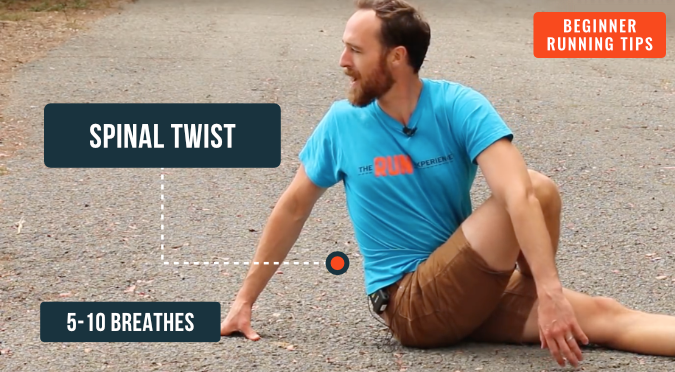
- After 5-10 breaths there, place the arm of the extended leg across/in front of your bent leg.
- Find a slight spinal twist, keeping the back as upright as possible.
- Now repeat the 5-10 big breaths, increasing the twist on each exhale.
Repeat everything on the other side!
Downward Dog
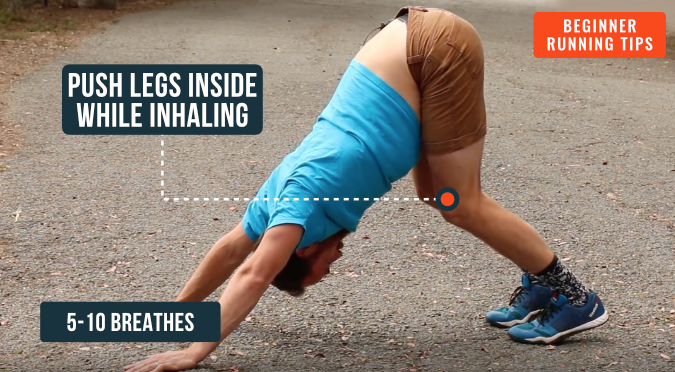
The last of our beginner running tips for unwinding after your run. Here’s how it works:
- Get onto all fours, on a flat surface.
- From here press up into an inverted “V” position.
- Feet and hands should be hips’ width apart.
- Palms and feet should be flat on the ground (ideally).
- Start by simply pedaling out the feet, giving the calves a light stretch.
- After a few seconds of this, find your still “V” position again.
- Now, you’ll take your 5-10 breaths, but with a little exaggerated movement.
- On the inhale: you’ll bend your knees toward your chest, driving the hips high to the sky, driving heels down to the ground.
- On the exhale: you’ll straighten your legs and press your chest through your hands, back toward your legs. *Heels stay flat.
- Repeat for 5-10 repetitions.
We know how many beginners running tips are out there, overwhelming you from every angle–on the internet, from your seasoned runner friends, in books, magazines, apps…the list goes on.
If you take nothing else away from this post, remember that your body can’t work for you if you don’t work for it! You’ve got 24 hours in your day. A stretching routine can take you less than 10 minutes a day. Trust us, these running stretches for beginners are worth it!
FAQ About Post-Running Stretches
What’s the best stretching routine for beginners?
The best stretching routine will involve loosening up and relaxing the entire body. Many runners make the mistake of only focusing on their lower body, but muscle tension in the neck and shoulders can be equally detrimental to your running health.
What are the top stretching exercises for beginners?
Downward dog is hands-down (get it?) the best stretching exercise for beginners. It’s easy to do, works a broad range of muscles, and feels downright wonderful. Plus, you can do it anywhere without a mat or any equipment.
How do you stretch after running?
Take it slow. Make sure you do a short 5-minute cooldown first, and then start from your toes and work your way up to your neck.
How do you stretch before a run?
Keep it light, and only stretch before a run after you’ve warmed up a bit. It’s best to jog for 10 minutes or a mile before doing any pre-run stretches to avoid pulling anything that’s still tight.
What are the best pre-run stretches?
The best pre-run stretches are more dynamic, such as lunges, leg kicks, and the like. Static stretches are best saved for after the run.
Post-Run Stretches Today Keep the Doctor Away
Often, athletes begin doing post-run stretches for runners after they’ve suffered an injury. Get ahead of the game.
Do a full-body stretch routine to prevent injuries in other places. While you might have tight calves today, your shoulders could begin feeling it tomorrow.
Don’t wait for a nagging injury to develop. Give yourself TLC today with the best post-running stretches to keep the doctor away.
Be sure to join our running community by downloading the mobile app and get access to even more of the best stretches for runners, training, tips, and routines!
